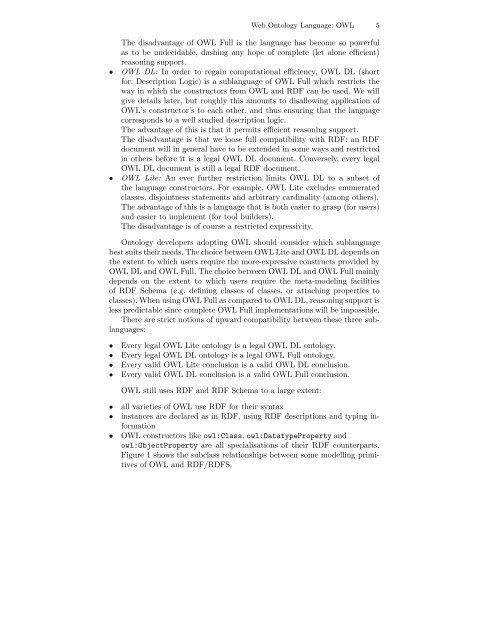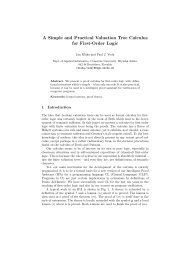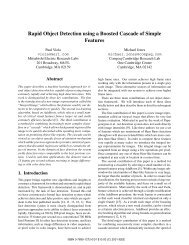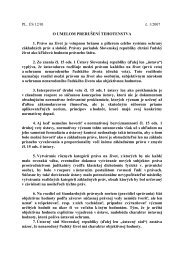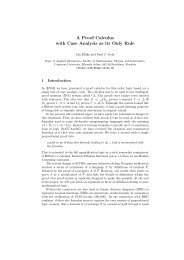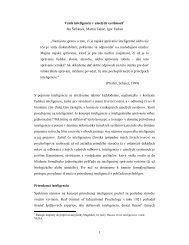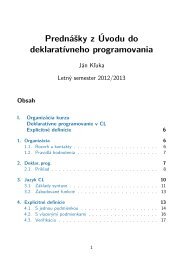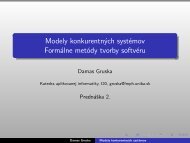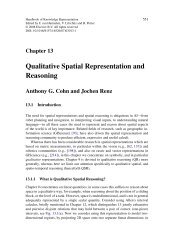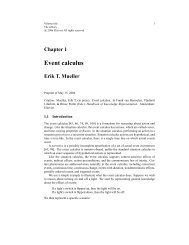Web Ontology Language: OWL - Vrije Universiteit Amsterdam
Web Ontology Language: OWL - Vrije Universiteit Amsterdam
Web Ontology Language: OWL - Vrije Universiteit Amsterdam
You also want an ePaper? Increase the reach of your titles
YUMPU automatically turns print PDFs into web optimized ePapers that Google loves.
<strong>Web</strong> <strong>Ontology</strong> <strong>Language</strong>: <strong>OWL</strong> 5The disadvantage of <strong>OWL</strong> Full is the language has become so powerfulas to be undecidable, dashing any hope of complete (let alone efficient)reasoning support.• <strong>OWL</strong> DL: In order to regain computational efficiency, <strong>OWL</strong> DL (shortfor: Description Logic) is a sublanguage of <strong>OWL</strong> Full which restricts theway in which the constructors from <strong>OWL</strong> and RDF can be used. We willgive details later, but roughly this amounts to disallowing application of<strong>OWL</strong>’s constructor’s to each other, and thus ensuring that the languagecorresponds to a well studied description logic.The advantage of this is that it permits efficient reasoning support.The disadvantage is that we loose full compatibility with RDF: an RDFdocument will in general have to be extended in some ways and restrictedin others before it is a legal <strong>OWL</strong> DL document. Conversely, every legal<strong>OWL</strong> DL document is still a legal RDF document.• <strong>OWL</strong> Lite: An ever further restriction limits <strong>OWL</strong> DL to a subset ofthe language constructors. For example, <strong>OWL</strong> Lite excludes enumeratedclasses, disjointness statements and arbitrary cardinality (among others).The advantage of this is a language that is both easier to grasp (for users)and easier to implement (for tool builders).The disadvantage is of course a restricted expressivity.<strong>Ontology</strong> developers adopting <strong>OWL</strong> should consider which sublanguagebest suits their needs. The choice between <strong>OWL</strong> Lite and <strong>OWL</strong> DL depends onthe extent to which users require the more-expressive constructs provided by<strong>OWL</strong> DL and <strong>OWL</strong> Full. The choice between <strong>OWL</strong> DL and <strong>OWL</strong> Full mainlydepends on the extent to which users require the meta-modeling facilitiesof RDF Schema (e.g. defining classes of classes, or attaching properties toclasses). When using <strong>OWL</strong> Full as compared to <strong>OWL</strong> DL, reasoning support isless predictable since complete <strong>OWL</strong> Full implementations will be impossible.There are strict notions of upward compatibility between these three sublanguages:• Every legal <strong>OWL</strong> Lite ontology is a legal <strong>OWL</strong> DL ontology.• Every legal <strong>OWL</strong> DL ontology is a legal <strong>OWL</strong> Full ontology.• Every valid <strong>OWL</strong> Lite conclusion is a valid <strong>OWL</strong> DL conclusion.• Every valid <strong>OWL</strong> DL conclusion is a valid <strong>OWL</strong> Full conclusion.<strong>OWL</strong> still uses RDF and RDF Schema to a large extent:• all varieties of <strong>OWL</strong> use RDF for their syntax• instances are declared as in RDF, using RDF descriptions and typing information• <strong>OWL</strong> constructors like owl:Class, owl:DatatypeProperty andowl:ObjectProperty are all specialisations of their RDF counterparts.Figure 1 shows the subclass relationships between some modelling primitivesof <strong>OWL</strong> and RDF/RDFS.


